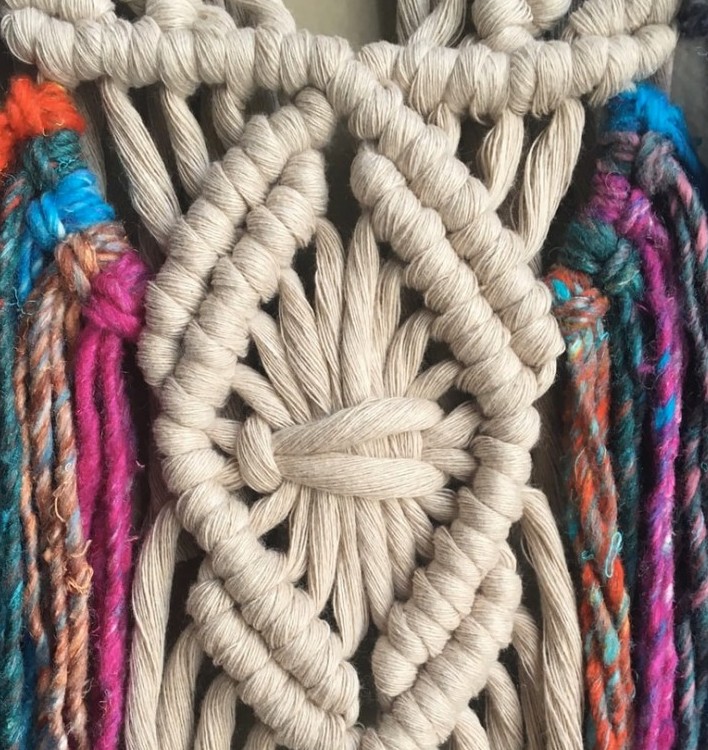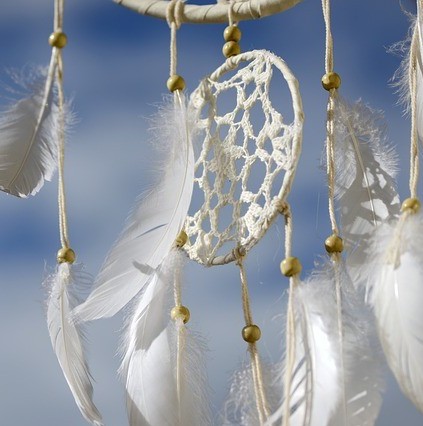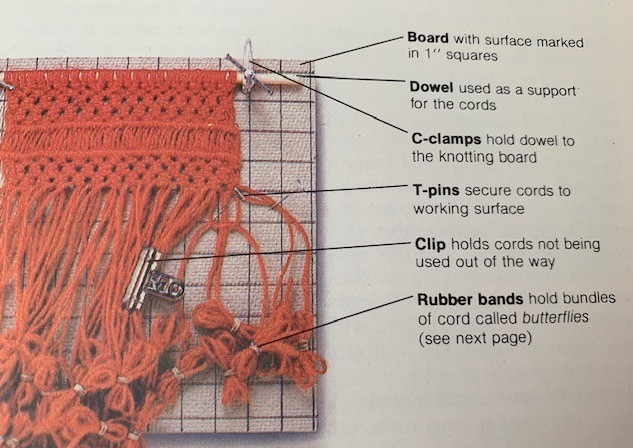In this post, I am going to look at the ancient art of Macrame, how it started, how you can get started and how to enjoy this art form as a great way to relax and be creative.
What Is Macrame?

Macrame is the art of ornamental knotting. It originated as a decorative way of securing the ends of a piece of woven fabric, thus creating a lacy edge.
Later macrame was worked separately and attached to both household items and even garments as a trimming.
In the Victorian era, entire items such as tablecloths, bedspreads, and curtains were made of macrame.
The word macrame comes from the word migramah which is Arabic for towel, shawl or the fringe on either one. It now means the process in itself, regardless of the finished item.
There is evidence that Macrame fringes were used in Arabia as early as the thirteenth century. From there the art spread very quickly all over the world.
Sailors also used to do macrame or knotting as it was known to them to while away their long hours at sea. They then used the belts, hammocks and bottle covers that they made for batter when they went ashore.
Macrame Cords


Macrame cord like this can be purchased online by just clicking on the picture above.
However, if you search through your household you will probably find something that you can practise with. The cord should be strong enough to withstand the abrasion of repeated knotting and should not have excessive give or elasticity.
You can use household string, butcher’s twine, or Venetian blind cord.
Yarn that one uses for knitting is not suitable for macrame.
The best macrame cord to use is cotton, linen and jute because they are readily available and knot easily. They are strong and come in a variety of weights and colours. They are also easy to dye. Note that Jute is not colourfast, so it should not be made into a project that will be used outdoors.
Silk cord also produces beautiful knots but is expensive and not always easy to find.
You could try synthetic cords like acrylic and polyester which knot easily and are weather resistant. They are usually available in bright colors and can be easily dyed.
Nylon and rayon are silky and shiny but tend to slip during knotting. Synthetics are often combined with natural fibres to give added strength and durability to a cord. Before you buy a large amount of cord for an entire project, try buying small amounts first to test. Make a 3 or 4-inch square and see how it looks. Then wash it to test for shrinkage.


What Do I Need To Start Macrame?
Macrame is one craft that doesn’t require a lot of tools to get started with. You will obviously need macrame cord and it may be a good idea to look at a knotting board like the one below.


The board has to be thick enough to support the work but porous enough to have pins inserted into it. You can click on the board to find out how to purchase it online.
To keep the cords and the knots even, the board is normally covered with paper marked off in 1-inch squares.
A C-clamp attached to the table makes a good anchor for working lengths of macrame like a belt for instance.
Macrame Terms And Abbreviations
The terms in macrame have evolved so that cords can be identified by their function as a piece is being worked.
A mounting cord is a support on which the other cords are tied. This, however, does not always have to be a chord. It could also be a ring, a dowel or a belt buckle.
Knotting cords are the cords that are actually tied in any given knot.
Anchor cords are those cords within a knot that are not tied, as in the centre of a square knot.
A holding cord or knot bearing cord is a cord on which other cords are tied as in the double half hitch knot.
Floating cords are any cords within a design that are not knotted. Areas of floating cords contrast nicely with knotted areas.
A sennit is a chain made up of a series of one kind of knot.
Abbreviations are used in macrame directions so that the names of the individual knots do not have to be repeated.
Where abbreviations are used, a key is provided, and this is especially helpful because some knots are known by more than one name.
Here are a few of the more common abbreviations:
ask – alternating square knot
ddhh – diagonal double half hitch
dhh – double half hitch
hdhh– horizontal double half hitch
hk – half knot
hc – holding cord
jk – Josephine knot
lh – lark’s head knot
ok – overhand knot
rih – reverse lark’s head knot
sk – square knot
vdhh – vertical double half hitch
How To Do Macrame
Nothing explains better than a video, so here is a video that will show you how to do the square knot, the spiral knot, and the half-hitch knot.


This book above will guide you through all the various knots and techniques required for the basics of Macrame.
Learn how to create elegant macrame pieces with this comprehensive guide from expert Dorothy Wood. All of the essential techniques are covered in detail with clear step-by-step photographs and instructions, taking you from beginner to expert in no time!
Once you’ve mastered the basics, there are also some jewellery projects included to test your skills. Click on the book to find out more.
More Tips For Setting Up
You normally start your macrame project with a length of cord. There is, unfortunately, no exact formula for estimating the length of cords necessary for a particular macrame project, but a good way to start is with individual cords that are seven to eight times the length of the finished piece.
This means that when the strands are folded over and mounted, each working cord will be three and one-half to four times longer than the finished piece.
As a beginner, you can add a little extra to your estimate because there are many factors that determine how much cord is needed.
If a design is predominantly verticle, like for instance a belt or plant hanger, less cord will be required than for a design with many horizontal areas.
If a design has lots of knots, it will take more cord than a design with areas of floating cords (cords without knots).
Tightly tied knots require more cord than loosely tied knots.
Thick cords are used up more rapidly than thin cords.
As you get more experience with Macrame, you will become better at estimating how much cord is needed for a particular project.
If you want to estimate how many cords you will need, you must first decide how wide the piece is going to be.
A belt may be 2 inches and a wall hanging maybe 15 inches wide.
Take the cord you have chosen and lay strands of it side by side until they equal one inch. Multiply the number in one inch by the number of inches in your piece to get the total number of cords needed.
 When measuring and cutting long cords, it can be a bit cumbersome, but there are several ways to do this efficiently.
When measuring and cutting long cords, it can be a bit cumbersome, but there are several ways to do this efficiently.
The simplest method is to measure out one length and then use that cord to measure all subsequent cords.
If you have many cords to cut, you can attach two c-clamps to the edge of a table, setting them a distance apart equal to half the length of your cord. Now tie the end of the cord to one C-clam, rape the cord around the other, and bring it back to the first.
This span will be equal to the length of one cord. Continue wrapping until you have the appropriate number of cords. Cut the cords at the first c-clamp. The cords will be halved and ready for mounting.
You can also measure cords using the backs of two chairs that are set a certain distance apart.
Another way is winding the cords around two doorknobs or between the handles of kitchen cabinets.
Anchoring Cords:
Macrame knots must be tied with the cords held under tension. The way to do this varies with each project.
If you have never worked macrame knots before, it is advisable to do the work on a board like the one above, so that you can pin cords to the board and follow the path of the cords.
As you become more adept at tying the knots, you may want to dispense with the knotting board.
There are several alternatives for anchoring the cords. If the cords are attached to a dowel between the handles of two kitchen cabinest, or a ladder bak or alatted chair. If the chair is not sturdy enough to supply the necessary tension, it can be weighted down with a stack of books.
Projects that are long and narrow, such as belts and plant hangers can be kept under tension by tying one end to a door know or the handle of a dresser drawer.
Types Of Macrame Knots
Here is a list of the most popular types of knots in Macrame:
- lark’s head knot
- lark’s head sennit
- double half hitch
- square knot
- square knot sennits
- alternating square knots
- the bobble
- gathering square knot
- overhand knot
- picots
- Josephine knot
- berry knot
So as you can see there are many different types of knots involved with Macrame, so you can never get bored. I find I tend to use the same ones again and again, just because I enjoy them more than the others.
There are loads of videos online showing you step by step what to do when creating your macrame projects. I however perfer having a book on hand to keep as a reference.
Please feel free to comment below if you have anything else to add on this fascinating hobby.

Thanks for this post in the art of macrame, Macrame it’s really something that looks like fun doing although I really don’t know how to make it or have any idea on what it’s made of until seeing this post.
You have really helped me a lot on how to get it started. I am going to try getting started on this as soon as possible.
Thanks for your comment Rose, and I am sure you are going to enjoy doing Macrame.
Oh, never heard of macrame before although knitting is something that I do for the fu that I get from it. I would very much like to give it a try. You have explained all the terms of the process and that is a very good thing. I like the fact that it has been a thing that has been used for a very long time. The fact that it has different weaves is good. I will watch your video and try it out. Thanks
Wow, it is good to see that macrame is something that anyone can do and it is not some kind of art passed down from a generation in a particular family. I have not seen anyone talk about it though. I am glad you could give us a brief background of how it all works. I feel the need to try out the different weaves. The things to get for this dont look so hard to come by.
I remember it went through a phase when I was a child and then it died down again. Even so it it still fun and relaxing to do and a useful skill to learn.